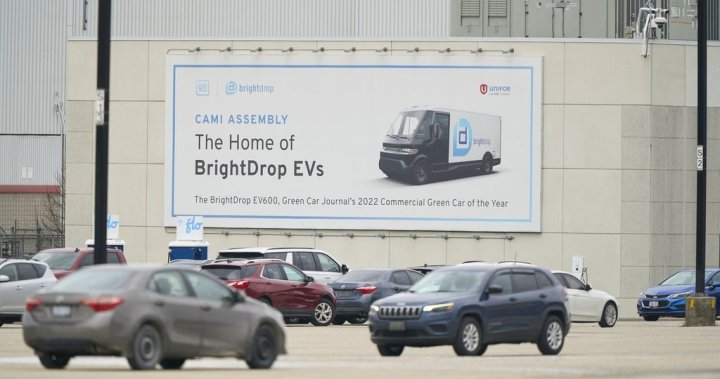Canada’s EV market was already in trouble. Tariffs made it worse, Ontario workers say

Bob Pulham recalls the optimism in the air when General Motors began producing electric vans in Ingersoll, Ont., in late 2022.
As the first BrightDrop commercial van rolled off the line at the CAMI Assembly plant, GM executives, union leaders and former prime minister Justin Trudeau touted it as a major milestone for electric vehicle production in Canada.
Pulham, a Unifor representative at the plant, remembers talk of increasing shifts and hiring more people to produce 50,000 such delivery vans annually by 2025.
But the sales never picked up, the plant kept slowing down the production line amid sluggish demand and the optimism slowly faded.
This April, GM announced it would idle the plant for several months and resume production in October with just one shift. Union members say about half of 1,200 workers at the plant will be gone as a result.
“I feel bad for all 600 that are being laid off. It’s a horrible position to be put in,” Pulham said in an interview. “It’s a crazy amount of uncertainty and I think that hurts people.”
The announcement came shortly after U.S. President Donald Trump imposed tariffs on Canadian-made vehicles, but a GM Canada spokesperson said the halt was directly related to lower-than-expected demand for the BrightDrop vans.
Pulham, who began working at the CAMI plant more than three decades ago, said his wife has also been laid off and is now pondering whether to go back to school or search for a new job.
Several other companies, including Honda, Stellantis, Umicore and Ford have also delayed or scrapped their EV projects amid the slow sales growth and the ongoing trade war.
GM Canada said reducing production in Ingersoll was necessary to adjust to market demand and balance inventory.
But workers at the CAMI plant say Trump’s tariffs made things even worse. They’ve experienced the industry’s ups and downs over the decades, but say this challenge is especially difficult at a time of great economic uncertainty.
“There’s a push to build (vehicles) in the U.S., and that has caused a lot of issues over here,” Pulham said. “So, it’s not a good situation.”
Mike Van Boekel, the Unifor Local 88 CAMI plant chairperson, said even though workers knew layoffs were on the horizon, the news was still shocking for many.
“It was terrible,” he said. “I thought we were going to lose a shift. I was worried in the back of my mind … and now it has come true.”
GM’s ambitious plan to be at the “forefront of a big wave” of electric delivery van production didn’t materialize because the timing was not right, Boekel said.
He felt the company was gaining some momentum before the imposition of 25 per cent tariffs on Canadian-made vehicles. GM had just received an order of a thousand delivery vans from the U.S. grocery chain giant Kroger, he said.

Get daily National news
Get the day’s top news, political, economic, and current affairs headlines, delivered to your inbox once a day.
“So, it looked like we were just getting to go and all of a sudden, the tariffs came on,” he said, adding that CAMI workers will still produce Kroger’s vans when they return to the factory this fall.
Workers aren’t the only ones feeling the pain.
The ripple effects of layoffs are a source of concern for Ingersoll Mayor Brian Petrie. The CAMI plant, which spans two million square feet, is the largest employer in the southwestern Ontario town of about 14,000 people.
Petrie said Ingersoll expects to receive $1.8 million in municipal taxes from the company this year, which is around 10 per cent of the total levies the town is expected to collect.
“It is devastating because we’re not talking about new employees here, either, these are long serving employees and … they’ve had a tough road going up to that point,” Petrie said in a recent interview at his office.
The federal government under Trudeau set a target of 100 per cent zero-emission sales of light duty vehicles by 2035. Environment Minister Julie Dabrusin indicated this week that mandate won’t be changing.
But that goal seems hard to achieve, Petrie said.
“It’s honest to say that I think everybody may have misunderstood the scale of the problem that we’re facing to do the EV switch,” he said. “I think all of them will admit that it’s been a bigger problem than they once thought.”
Still, he thinks the more than $50 billion in investments that Canada has pledged since 2020 to incentivize the EV supply chain will pay off in the long term.
Some provinces, including Manitoba and Quebec, are offering rebates for electric vehicle purchases. B.C.’s rebate program, which was the longest running in the country, was paused last month. Ontario scrapped its rebate program after Premier Doug Ford’s Progressive Conservatives won the election in 2018.
The federal government also halted in January its Incentives for Zero-Emission Vehicles program, which offered up to $5,000 off the cost of a new electric vehicle. Dabrusin said Ottawa intends to bring back consumer rebates for EVs, but doesn’t yet know what they’ll look like.
Zero-emissions vehicles represented only 8.7 per cent of all new vehicle sales in Canada in the first quarter of 2025 — a drop from 16.5 per cent in the fourth quarter of 2024, according to data from Statistics Canada.
The sales of EVs and plug-in hybrids had steadily increased from below one per cent in 2017 to 14.6 in 2024, but experts say the growth hasn’t been nearly as fast as many expected.
Dan Park, CEO of online used car retailer Clutch, said EV adoption has been slower in Canada because people normally drive long distances in colder temperatures, which reduces battery life by 20 to 40 per cent and slows down the charging speed.
“Canada is just a fundamentally harder market to have,” he said. “Until technology and battery life is improved to be able to handle colder conditions, I think Canadians will just shy away from it.”
Park said EVs make up only five per cent of Clutch’s inventory, which is tied to consumer demand.
He said consumer rebates and production subsidies “artificially propped up the market,” and provincial and federal governments should instead invest in a stronger charging infrastructure to encourage more Canadians to adopt EVs.
A recent survey by consumer insights firm J.D. Power shows that only 28 per cent of nearly 4,000 respondents said they were “very likely” or “somewhat likely” to consider an EV for their next vehicle purchase, down from 29 per cent last year and 34 per cent in 2023. The survey also found that 75 per cent of new vehicle purchasers aren’t confident Canada can reach its 2035 zero-emission vehicle sales goal.
Manufacturers took note of the lacklustre interest.
Honda Canada announced in May that it’s postponing a $15-billion EV project in Ontario, citing the “unexpected slowdown” in the market. Stellantis is postponing the production of an EV model of 2026 Dodge Charger Daytona R/T at its Windsor, Ont., plant as it assesses the effects of U.S. tariffs. And Ford Motor Co. said it will assemble F-Series Super Duty pickup trucks at its Oakville, Ont., plant beginning in 2026 instead of planned electric vehicle production at the site.
Despite the setbacks, Environment and Climate Change Canada said it will continue to support investments and innovations in the EV supply chain.
Canada’s zero-emissions vehicle sales mandates ensure “Canadians have access to electric vehicles, which offer long-term savings for consumers,” department spokesperson Hermine Landry said in a statement.
“Transportation emissions have declined to levels not seen in decades, demonstrating that we can grow our economy while also fighting climate change,” Landry said. “It is important to remain focused on the fact that the real threat to the Canadian auto industry right now are the unjustified tariffs from the United States.”
Overall, Canadians buy around two million new vehicles annually and the country produces approximately 1.5 million of them, according to Unifor. Autoworkers say the federal government should push for more vehicle production in Canada from manufacturers such as Kia, Hyundai, Mitsubishi and others that don’t have any production footprint in the country, to offset the impact of U.S. tariffs.
“It’d be nice, (if) the government stands up for us and you know says to these big companies, ‘If you want to sell here, then you need to build here as well,’” said Paul Harvey, who works as a framing team leader at CAMI.
Harvey said that although he and his wife will keep their jobs at the CAMI plant in Ingersoll, they will both have to work the same hours when production resumes on one shift. With four children at home, that means the couple will need a new child-care plan and increased costs will come with it.
Harvey, who has been an autoworker for 20 years, said it would be “kind of silly” to think that the transition to electric vehicles would happen at the flick of a switch. He said he and his wife remain optimistic about the EV market and that’s why they purchased a Chevy Blazer EV just a few weeks ago.
“We’re committed to moving into the future with the electrified vehicles,” he said.
“I do believe it will get there eventually.”


Spirits maker Diageo will cease operations at its bottling facility in Amherstburg, Ont., early next year, as it shifts some bottling volume to the U.S., the company announced on Thursday.
The facility, which bottles Crown Royal products, will close in February in a move aimed at improving its North American supply chain.

Get breaking National news
For news impacting Canada and around the world, sign up for breaking news alerts delivered directly to you when they happen.
About 200 jobs will be affected.
“This was a difficult decision, but one that is crucial to improving the efficiency and resiliency of our supply chain network,” Marsha McIntosh, Diageo’s president of North America supply, said in a statement.
Diageo said it will engage with the community and find ways to support its employees through the transition, and work alongside Unifor to assist unionized workers.
The company said it will still maintain a “significant” footprint in Canada — including its headquarters and warehouse operations in the Greater Toronto Area, and bottling and distillation facilities in Manitoba and Quebec.
McIntosh added the company’s Crown Royal products will continue to be mashed, distilled and aged at its Canadian facilities.
© 2025 The Canadian Press

Toronto police say a 33-year-old man has been charged with attempted murder after allegedly striking two men with his car Wednesday evening.
Officers say they responded to reports of a collision in the area of Don Mills Road and Gateway Boulevard in the city’s North York neighbourhood just before 10:30 p.m.

Get daily National news
Get the day’s top news, political, economic, and current affairs headlines, delivered to your inbox once a day.
Police say two men got into an argument, leading to one man getting into his car and hitting the other man with it.
They say the man then put his car into reverse, striking a second man.
A man in his 50s was transported to hospital with serious injuries and the second man, in his 20s, had minor injuries.
Police say the suspect from Markham, Ont., faces several other charges as well, including two counts of assault with a weapon, uttering threats and dangerous driving.
© 2025 The Canadian Press

A court document shows a Lindsay, Ont., man facing charges for allegedly breaking into an apartment was carrying a crossbow when he was confronted by a tenant.
The resident, Jeremy David McDonald, is also facing assault charges in the incident on Aug. 18 — a fact that has generated widespread interest in the case.
Police information filed in court alleges that Michael Kyle Breen damaged a window and screen at McDonald’s home and carried a crossbow.
The court document says the 41-year-old Breen is charged with break and enter, possession of a weapon for a dangerous purpose, mischief under $5,000 and failing to comply with a probation order.

Get daily National news
Get the day’s top news, political, economic, and current affairs headlines, delivered to your inbox once a day.
Police have said that Breen, who is scheduled to appear in court for a bail hearing next week, was already wanted for unrelated offences.
McDonald, the 44-year-old resident, was charged with aggravated assault and assault with a weapon after he allegedly “did endanger the life” of Breen.
Premier Doug Ford blasted the decision to charge the apartment resident, saying last week that it shows “something is broken.”
Kawartha Lakes Police Chief Kirk Robertson wrote in a statement Wednesday that he recognizes the incident has generated significant public interest and “emotional” responses, but called some of the reaction “unjust and inaccurate.”
Robertson wrote that individuals have the right to defend themselves and their property, but the law requires that any defensive action be proportionate to the threat faced.
“This means that while homeowners do have the right to protect themselves and their property, the use of force must be reasonable given the circumstances,” he wrote.
© 2025 The Canadian Press
-

 Uncategorized3 months ago
Uncategorized3 months agoShop Proud, Eat Proud, Be Proud — Ottawa Canada Day Market This June 28th
-

 3 months ago
3 months agoCanada’s world junior trial saw juries tossed, intense testimony. Here’s a recap
-

 2 months ago
2 months agoRing of Fire road to bring prosperity to First Nation, problems for caribou: report
-

 3 months ago
3 months agoMeasles circulating in northeastern B.C. community, health officials warn
-

 3 months ago
3 months agoAnishinabek Nation chief says he briefed Ontario police on protests against Bill 5
-

 2 months ago
2 months agoFormer major leaguer, Jays doctor Ron Taylor dies
-

 2 months ago
2 months agoJagmeet Singh apologizes for attending Kendrick Lamar concert after Drake calls him out
-

 2 months ago
2 months agoDreaming of a lakeside cottage but can’t afford it? Co-ownership could open that door





